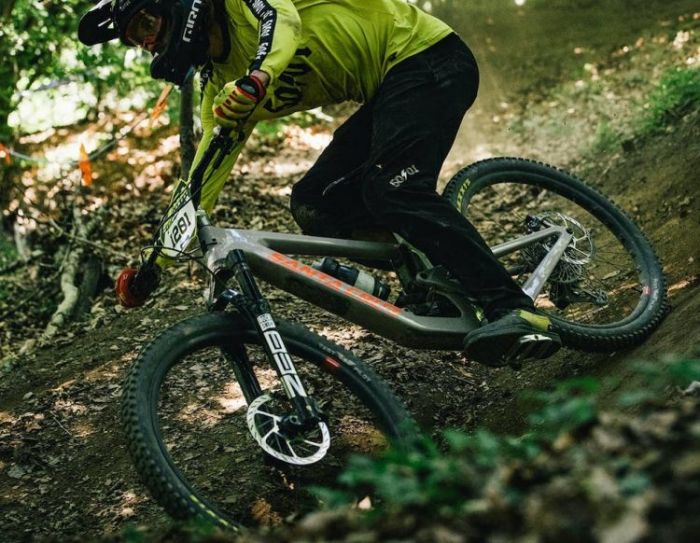Specialized Epic Hardtail Mountain Bike
- Price: $2,500
- Frame: Carbon
- Gear: 1×12
- Tires: 29×2.35
What we like about it: The carbon fiber body and wide range of 1×12 gears make for a fast, light, confident climber.
What we don’t like about it: Not enough choice of two paint colors to satisfy more people’s choice of paint.
Rating: (4.7/5)
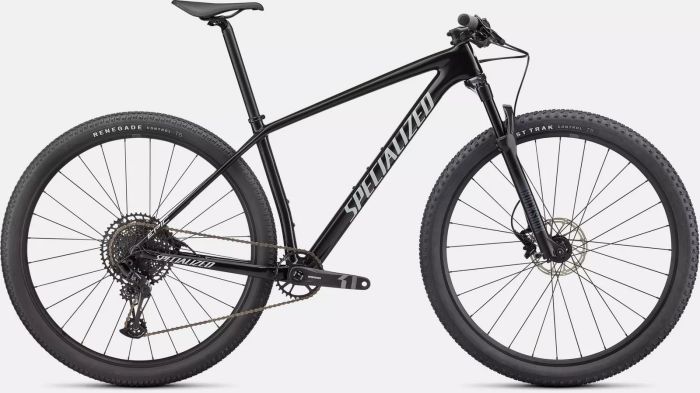
In fact, with a hardtail bike, we want it to be able to climb on rugged singletrack, winding rocky trails.
The Specialized Epic Hardtail Bike is the one that caught our eye. With a compact, lightweight frame, powerful SRAM Level T hydraulic disc brakes, a clean and refined SRAM NX Eagle, 12 speeds, and a RockShox fork, we were pleasantly surprised at how well it performed on technical trails.
After three months of riding this bike with me through uncharted forest roads, watching the sun set over rocky mountain tops and crushing gravel trails. I felt the bike’s outstanding climbing ability and the hardtail’s excellent performance on gravel roads, and it made climbing seem like a less difficult task.
Below we break down the climbing performance, descent performance, key features, components, and specs of the Specialized Epic Hardtail Bikes well as other versions.
If you want more bike reviews, you can follow us.
Climbing Performance
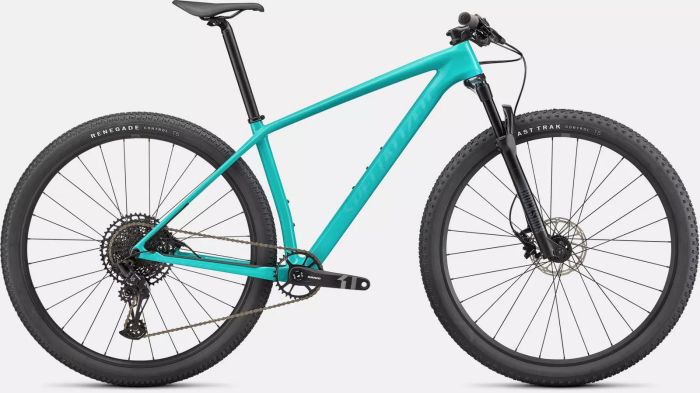
For a hardtail bike, climbing performance is one of its essential strengths. But the Specialized Epic Hardtail still dazzles me with its climbing performance.
First of all, the Specialized Epic Hardtail’s carbon fiber construction makes the entire body lighter, and the lack of rear shock may make some people think it will make the rider face bumps. In actual riding, it is precisely the lack of rear shock that reduces the weight of the body and at the same time reduces the increase in speed due to the kinetic energy absorbed by the rear shock, which is more energy efficient.
On this winding rocky singletrack that I was about to climb. The singletrack was like a snake around this rocky mountain and the path had many deep ruts and loose rock chunks, which definitely made the climb more difficult for my ride.
But the excellent partner Specialized Epic Hardtail with its clean and refined 1×12 shifting and super grippy 29×2.35 tires allowed me to enjoy the sunset view from the top of the mountain with a smile on my face.
The lack of dropper on the Specialized Epic Hardtail made me a little anxious before I started riding. The moment I actually gripped the handlebars, all my anxiety and worries magically disappeared.
Yes, you guessed it right, the carbon fiber construction not only makes the Specialized Epic Hardtail light, but it has the ability to absorb shock better than steel when facing bumps. So, in the face of dirt piles, the Specialized Epic Hardtail can easily fly on such roads.
All things considered, the Specialized Epic Hardtail is a competent hardtail bike, and its standout component configuration makes it even more enticing.
Descending
Many people have the inherent impression that hardtail bikes have no way to keep up with full suspension bikes or professional downhill bikes of the same price when it comes to descending. I won’t deny it, most hardtail bikes do have a shortcoming when it comes to descending.
In this case, in my experience with the Specialized Epic Hardtail on an actual descending ride, it blew me away! (Even though it fell short of the great professional descenders I’ve ridden before).
The Specialized Epic Hardtail’s proper 115.5cm wheelbase allows for more stability on descents, and it turns deftly on tight trails. 100mm of fork travel (which seems a bit short) is matched by an air spring that not only keeps its weight down on descents, but also responds sensitively to bumps, allowing me to get around this descending trail jump with ease.
Even in the event of a hard stop, the Specialized Epic Hardtail’s SRAM Level T hydraulic disc brakes provided a strong bite to keep me firmly on the ground.
All in all, even though the Specialized Epic Hardtail’s descent performance is not as good as that of a professional speed bike, in my real-world experience, its descent performance is worthy of praise.
Main features
Specialized Epic Hardtail Frame
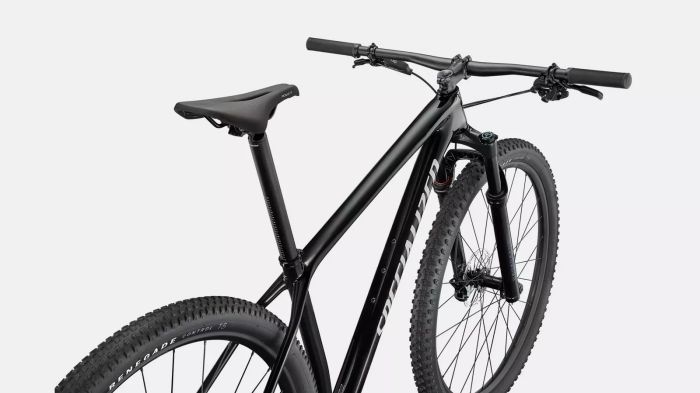
The frame of the Specialized Epic Hardtail is the carbon fiber frame that we should expect. If all you know about carbon fiber is that it’s expensive, then I’m speechless about it.
Carbon fiber is a low-density material, and because of its low density, it can absorb more road vibration and give you a better riding experience. So we were shocked at the carbon fiber frame of the Specialized Epic Hardtail, after all, it only costs $2,500.
In fact, the Specialized Epic Hardtail’s two paint colors, Gloss Tarmac Black and Chameleon Eyris, both appeal to me. I also have to say that the two paint colors are not rich enough and it could use a little more paint color if possible.
In addition, its internal alignment is also in line with the current fashion, clean and crisp. This is very easy to clean even if the car tube is covered with mud.
Also configured with two water bottle mounting holes, you can enjoy your ride away from the hustle and bustle of the noisy city life with plenty of water, so you won’t have to give up your ride because you can’t get enough water to replenish it.
Geometry
What is the standard geometry? I think this is an unanswerable question, there is no absolute standard geometry, only the geometry that suits you. But I have to say that the engineers of the Specialized Epic Hardtail have very close control of the geometry.
With the steep seat tube angle (74°) of the Specialized Epic Hardtail, it makes my pedaling easier. When I want to go faster, I can flex my spine and adjust to a more suitable aero position to maintain speed.
In addition, the slacker head tube angle (68.5°) made it easier to face the descent without going over the bars. It can also climb a single track effectively at low speeds.
If you notice its proper Reach (43cm), this allows you to comfortably stretch your arms, leaving your front torso and arms in a proper position. You will not be hindered by a short or long Reach.
Components and Specifications
SRAM NX Eagle 1×12 Drivetrain
Only choose the right one, not buy the expensive one, adhering to this idea, we carefully studied the Specialized Epic Hardtail.
As we all know, SRAM’s transmission is widely used in mountain biking, and every release of its transmission set will cause many riders to discuss it. Specialized Epic Hardtail’s SRAM NX Eagle 1×12 transmission is not new anymore.
However, it is worth mentioning that all Eagle series discs are equipped with DUB center shafts and direct mount discs. The discs have an X-Sync tooth profile optimized for 12-speed chains, so you don’t have to worry about dropping the chain when facing shifts. In addition, the NX’s finger chainstay is very light.
In my actual riding, its 1×12 shifting is enough for me and the streamlined shifting really makes me love it. Even a novice would praise its simple and safe shifting.
SRAM Level T Hydraulic Disc Brake
When we talk about the safety of the bike, we have to mention its brakes. We can see that the Specialized Epic Hardtail uses SRAM Level T hydraulic disc brakes. These brakes are designed as trail brakes, and at first, when riding on forest trails, I found that the braking was not adequately demonstrated on the leafy trails.
When I started riding on rocky trails and slightly slabby country roads, I found that it still had very strong braking ability.
Even though it’s only a 2-piston brake, the weight will be lighter and some might think it won’t provide strong braking on technical trails.
It won’t let you down with its braking on normal off-road trails. Even on rainy roads, you can trust it completely. Not only that, its affordable price is really tempting.
Tires
Tires are like our feet, strong enough tires can carry us to longer distances. We noticed that the front and rear tires of the Specialized Epic Hardtail are the same size, but they are not the same model. The front tire is the Fast Trak and the rear tire is the Renegade.
This was observed and reviewed, and the Fast Trak has a more aggressive tread pattern, which allows it to handle technical roads. It is capable of fast rolling even in tough road conditions and the larger external structural support adds speed, traction, support, and stable handling.
Moreover, the rear tire Renegade is perfect for acceleration, even when facing corners, and it is able to confidently maintain speed in the turns.
Not only that, but to be more adapted to the XC track, its tires have better wear protection.
Other Versions of the Specialized Epic
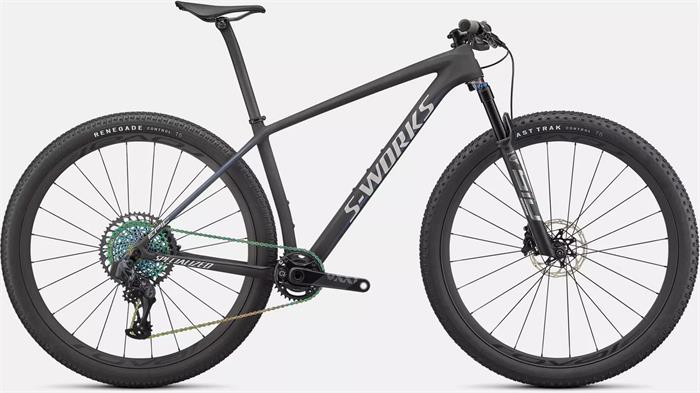
In this review, we reviewed the Specialized Epic Hardtail’s frame, SRAM NX Eagle drivetrain, and SRAM Level T hydraulic disc brakes. Over the course of three months, we got a good feel for its wide, nimble shifting and stable braking, which left an indelible impression on me on both climbs and descents.
For this reason, we looked up the Specialized S-Works Epic Hardtail, a premium version of the Specialized Epic, which retails for a whopping $11,000. The brakes and forks are super high-end, so if you want to know more about the Specialized S-Works Epic Hardtail, you can follow us and we’ll keep you updated.
What do we like about it?
- Streamlined and smooth 1×12 shifting that allows me to shift into the right gear for any situation.
- Wear-resistant tires have traction and grip that you can’t imagine.
- Fitted geometry allows you to ride in comfort.
- Unexpected carbon fiber frame gives you unexpected results at a lower price.
- Air springs cushion the shock in a softer, smoother way.
What we don’t like about it?
- Too few paint color options.
- Some people think the 2-piston brakes are too few for consistent braking in extremely rough terrain (in my real-world experience, it played consistently).
FAQs
- What is the frame material of the Specialized Epic Hardtail?
The frame of the Specialized Epic Hardtail is Carbon.
- What size are the tires on the Specialized Epic Hardtail? What brand are they?
The tire size of Specialized Epic Hardtail is 29×2.35″, its front tire is Specialized Fast Trak and its rear tire is Specialized Renegade.
- Which height does the Specialized Epic Hardtail fit?
The sizing chart for the Specialized Epic Hardtail is as follows.
| S | 5’1″ – 5’6″ |
| SM | 5’4″ – 5’9″ |
| MD | 5’7″ – 6’0″ |
| LG | 5’10” – 6’3″ |
| XL | 6’0″ – 6’5″ |
Specs
FRAMESET
| Frame | Specialized FACT 11m, Progressive XC Geometry, Rider-First Engineered邃「, threaded BB, 12x148mm rear spacing, internal cable routing |
| Seat Binder | Specialized Alloy 34.9 |
Suspension
| Fork | RockShox Judy Gold, Motion Control damper, Solo Air, 42mm offset, 15x110mm thru-axle, 100mm of travel (XS – 80mm travel) |
COCKPIT
| Stem | 3D-forged alloy, 31.8mm, 7-degree |
| Handlebars | Specialized Alloy XC minirise, double-butted alloy, 8-degree backsweep, 6-degree upsweep, 10mm rise, 31.8mm |
| Tape | Specialized Trail Grips |
| Saddle | Body Geometry Power Sport, steel rails |
| SeatPost | Specialized Alloy, Single Bolt, 30.9mm |
BRAKES
| Front Brake | SRAM Level T hydraulic disc, 2-Piston Caliper |
| Rear Brake | SRAM Level T hydraulic disc, 2-Piston Caliper |
DRIVETRAIN
| Rear Derailleur | SRAM NX Eagle, 12-speed |
| Shift Levers | SRAM NX Eagle, trigger, 12-speed |
| Cassette | SRAM NX Eagle PG-1230, 12-speed, 11-50t |
| Chain | SRAM SX Eagle, 12-speed w/ PowerLockツョ |
| Crankset | SRAM X1000 Eagle, DUB, 170/175mm 32T |
| Chainrings | 32T |
| Bottom Bracket | SRAM DUB, BSA 73mm, threaded |
WHEELS
| Rims | Specialized Alloy, Tubeless Ready, 25mm internal width, 28h |
| Front Hub | Alloy, sealed cartridge bearings, 15x110mm thru-axle, 28h |
| Rear Hub | Alloy, sealed cartridge bearings, 12x148mm thru-axle, 28h |
| Front Tire | Specialized Fast Trak, Control Casing, T5 Compound, 29×2.35 |
| Rear Tire | Specialized Renegade, Control Casing, T5 Compound, 29×2.35 |
| Inner Tubes | Standard, Presta valve |
| Spokes | Stainless, 14g |
Comparison Table
| BIKE | PRICE | Drivetrain | BRAKE | TIRE | CLICK VIEW |
| Ghost Lector SF | $2,754 | 1×12 | Formula Cura 2 180/160 mm Disc Brakes | 29×2.25” | Click View |
| Trek Procaliber 9.5 | $2,449.99 | 1×12 | Shimano MT200 Hydraulic Disc Brakes | 29×2.40″ | Click View |
| Specialized Chisel Comp | $2,400 | 1×12 | SRAM Level T Hydraulic Disc | 29×2.35” | Click View |
| Liv Pique 29 2 | $2,600 | 1×12 | Shimano MT410 Hydraulic Disc | 29×2.25” | Click View |
Specialized Epic Hardtail vs Ghost Lector SF
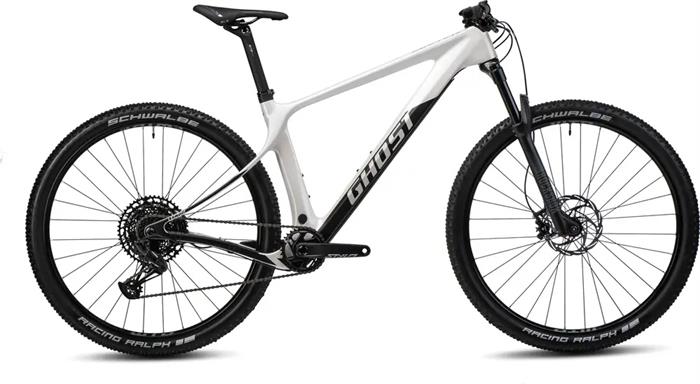
The Ghost Lector SF is $254 more expensive, but in terms of frame material, they are both made of carbon fiber. I would prefer the Specialized Epic Hardtail for its affordability alone.
In addition, we can see that both of them are 1×12 shifting. On my actual ride, the Specialized Epic Hardtail would be a bit softer. In terms of braking, the Ghost Lector SF uses Formula Cura 2 180/160 mm disc brakes.
It’s no exaggeration to say that it’s a simple and efficient brake, but I’d rather ride the Specialized Epic Hardtail in the SRAM Level T hydraulic disc brakes that I’m used to.
Plus, they’re almost identical in terms of speed (25 mph uphill, 27 mph downhill), so if you’re considering value for money, give the Specialized Epic Hardtail a try.
Specialized Epic Hardtail vs Trek Procaliber 9.5
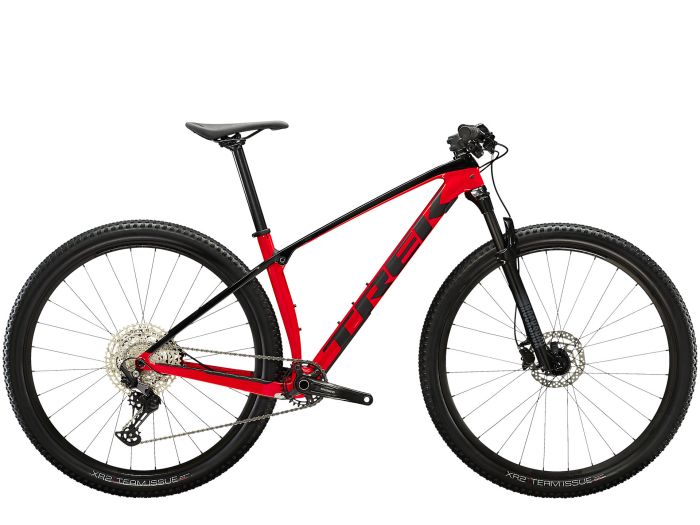
If I hadn’t ridden the Trek Procaliber 9.5 for a long time, I wouldn’t have understood it as thoroughly as I did. First of all, its OCLV carbon frame is lighter and stronger than regular carbon, so it’s already very good in that respect.
Its IsoSpeed decoupler is more responsive to small vibrations and bumps, and they are very close in price. So if I had to make a choice between them, I’d be really hesitant.
In practice, the wide range of 1×12 shifts on both bikes was more than adequate for me, but I was more impressed with the SRAM NX Eagle on the Specialized Epic Hardtail. It’s smoother and more streamlined when shifting, with a unique chain optimization that allows me to shift with more abandon.
But I also have to be honest and say that in real-world climbs, the Trek Procaliber 9.5 was 26 mph uphill for the same amount of stamina, while the Specialized Epic Hardtail was 25 mph uphill. My personal experience while riding the Specialized Epic Hardtail was that it allowed me to save more effort while enjoying the climbs more.
If you need a quality XC, both are great bikes for the money and you can choose the best one for you based on the trails you ride regularly, and your riding habits.
Learn more: Trek Procaliber 9.7 Review: How Does It Perform On The Field?
Specialized Epic Hardtail vs Chisel Comp
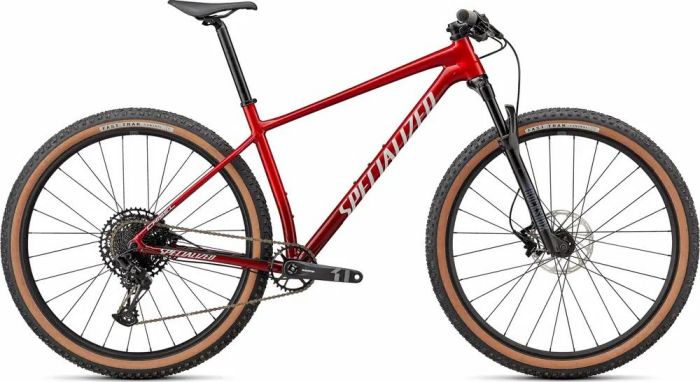
The Specialized Chisel Comp’s three paint colors are attractive enough. Although the Specialized Epic Hardtail has one less paint color to choose from, the Specialized Epic Hardtail’s paint job is just as eye-catching.
However, it is worth mentioning that they are both Specialized, so there are some similarities in the components, which is inevitable. For example, in terms of braking, they are both SRAM Level T hydraulic discs. The brakes are described in detail in the previous article, so I won’t dwell on them here.
The Specialized Epic Hardtail front and rear tires are not made of the same material (Specialized Fast Trak for the front and Specialized Renegade for the rear). In terms of grip and cornering traction, the Specialized Chisel Comp is more impressive.
However, the Specialized Chisel Comp is not a bad tire either, with the Specialized Fast Trak front and rear, but I prefer the Specialized Epic Hardtail on gravel and wet trails.
If you ride a lot of trails with a lot of gravel and slippery surfaces, you might want to check out the Specialized Epic Hardtail.
Learn More: Specialized Chisel Come Reviews – Great Value For Money?
Specialized Epic Hardtail vs Liv Pique 29 2
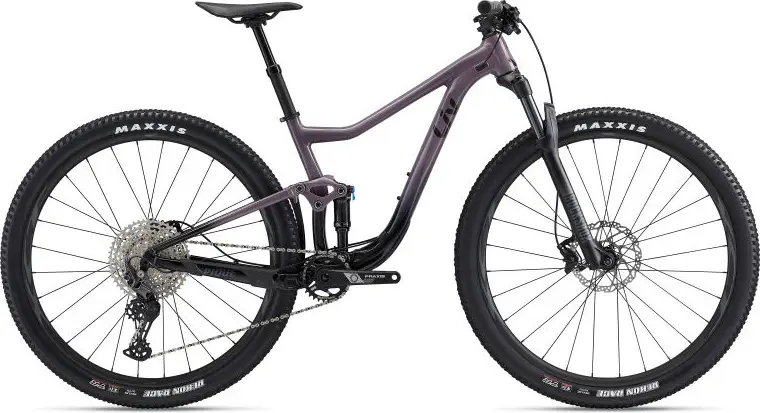
We can clearly see that the Liv Pique 29 2 is a full suspension trail bike with an aluminum frame and the same wide range of 1×12 speeds which allows it to face all kinds of terrain. We can see that its 2.25” tires may be a bit of a hindrance for novices in terms of control when facing loose ground. However, the full suspension design is undeniably good at absorbing vibrations when facing bumps.
But the Specialized Epic Hardtail is no slouch either. Some may think that its hardtail design is not as good as the Liv Pique 29 2 in terms of shock absorption, but you may not have considered the special features of the Specialized Epic Hardtail’s carbon fiber.
Carbon fiber is also very effective in absorbing vibrations, and the Liv Pique 29 2’s aluminum frame is a bit heavier than the Specialized Epic Hardtail. In addition, the Liv Pique 29 2 costs $100 more than the Specialized Epic. Specialized Epic Hardtail’s SRAM NX Eagle 1×12 is more advanced, and it gave me a butter-smooth shift in real-world riding.
So, if you’re looking for a great XC at a great price, you should check out the Specialized Epic Hardtail.
In case, the above comments are helpful to you, please remember to share the subscription. Have a great day!

![[Orbea URRUN 10 20mph Review] – Best Used By People Who Enjoy Riding To Get AFeel For The Mountains!](https://bestbikeselect.com/wp-content/uploads/2023/09/2023-Orbea-URRUN-10-20mph-35_-1024x1024.jpg)
![[Specialized Turbo Como 5.0 Review] – Good Choice?](https://bestbikeselect.com/wp-content/uploads/2023/08/2023-Specialized-Turbo-Como-5.01_-1024x1024.webp)
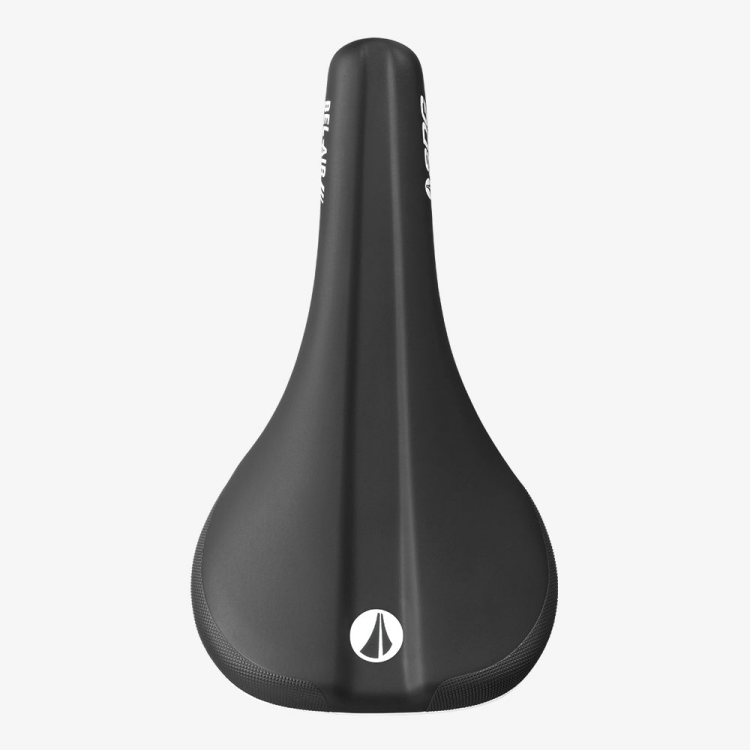
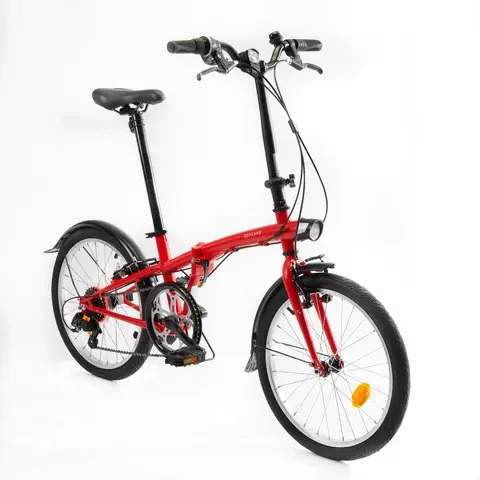
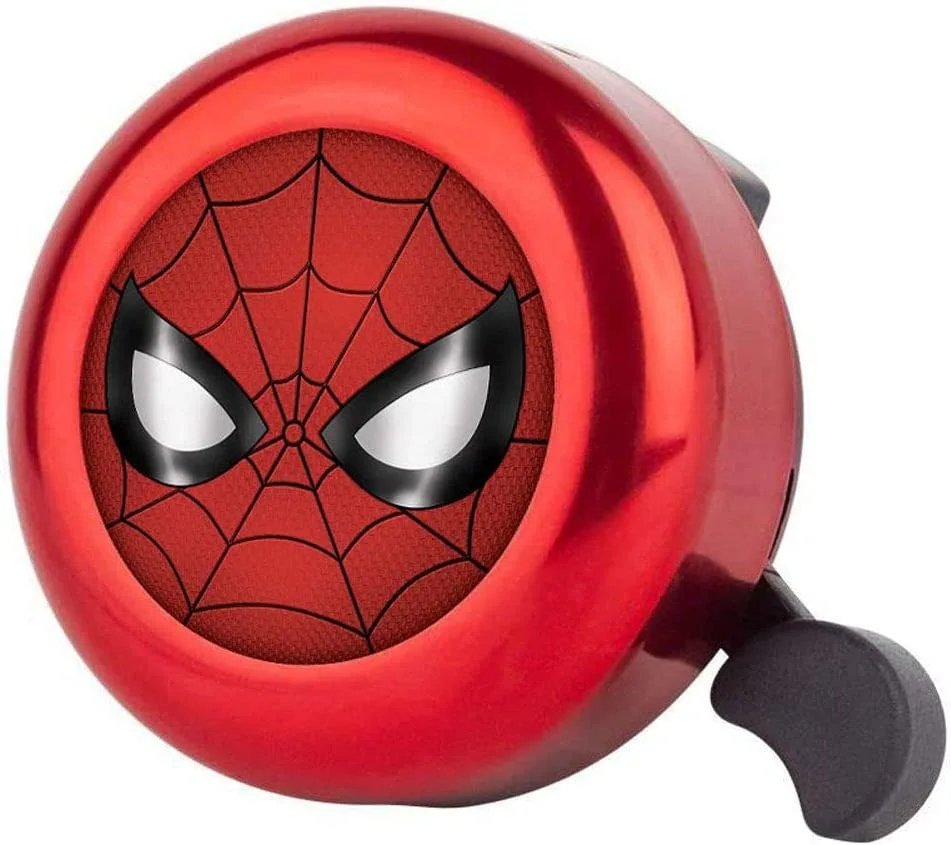
![2025 Built for Champions:[Orbea ORCA M21eTEAM PWR Review]](https://bestbikeselect.com/wp-content/uploads/2025/01/ORCA-M21eTEAM-PWR-1024x885.jpg)
![2025 Conquer Any Trail [Santa Cruz Bronson R Review]](https://bestbikeselect.com/wp-content/uploads/2025/01/Santa-Cruz-Bronson-R-1-1024x768.webp)
![2025 The All-Terrain Beast [Santa Cruz Hightower 3 MY24 Review]](https://bestbikeselect.com/wp-content/uploads/2025/01/Santa-Cruz-Hightower-3-MY24-1024x768.webp)
![The Best Comfortable Leisure Bike of 2025 [ Trek Verve 2 Lowstep Gen 5 ]](https://bestbikeselect.com/wp-content/uploads/2024/12/Verve-2-Lowstep-Gen-5-02-1024x681.png)
![2025’s Top Endurance Bikes [Cannondale Synapse Carbon 3 L Review]](https://bestbikeselect.com/wp-content/uploads/2025/01/Cannondale-Synapse-Carbon-3-L-1-1024x627.webp)
